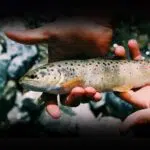National Catch and Release Day falls on the second Saturday in April. This year, it takes place on April 11. It is celebrated annually every second Saturday of April. It’s a day to commend all anglers of varying skills who practice the catch and release method of fishing. It’s also the perfect time to promote this technique that helps conserve native fish species among other recreational fishermen. We applaud this catch and release method because it does not harm native fish populations. If anything, by releasing the fish back into the water, this method encourages increased fish populations and a balanced ecosystem.
History of National Catch and Release Day
Fishing was originally practiced as man’s means to provide himself with food by catching fish in freshwater or saltwater using a rod, line, and hook. Fishing is still popular today, both as a sport and as a part of the economy of some countries.
Catch and release is a practice in recreational fishing when the fish is returned to the water after its capture. Usually, quick measurement and weighing are done first, followed by a photo as visual proof of the catch, then the fish is unhooked and returned alive back into the water. If barbless hooks are used with a slack line, it’s possible to release the fish without taking it from the water. It was developed to prevent the overharvesting of fish because of increasing ecological pressure, growing human populations, and habitat degradation.
Sport fishermen have been using this method for decades, especially with some highly pressured fish species. A Montana-based fly shop owner named Don Martinez promoted it in his newsletters in the 1930s-1940s sent to eastern anglers. It was first introduced in Michigan in 1952 to reduce the cost of stocking hatchery-raised trout. Those fishing for fun instead of food accepted the concept of releasing the fish while in no-kill zones. Today, in many areas of the U.S. and Canada, individual streams and lakes are managed for lower catch limits and habitat quality. Fishery management continues to shift from replenishing streams and lakes to enhancing existing water habitats and quality. This is so that the species found in a body of water can thrive better through natural reproduction.
National Catch and Release Day timeline
An Egyptian fishing scene shows figures fishing with a rod, line, and nets.
Chinese accounts are found describing fishing with bamboo rods, silk lines, a hook made of a needle, and cooked rice used for bait.
English nun Dame Juliana Berners writes about fishing for sport in the U.K.
Lee Wulff, a fly angler and author from New York, uses the phrase, “Game fish are too valuable to be only caught once.”
The first bass fishing catch and release tournament is held in Florida.
National Catch and Release Day FAQs
Can fish feel pain?
Scientific studies suggest that fish can feel pain.
What percentage of fish survive catch and release?
It depends on the type of fish and how they are caught. The average survival rate is between 84% to 98%. Some fish are more resilient and less prone to stress.
Do fish remember being caught?
Researchers have found that wild fishes can remember being caught up to 11 months after, and try to avoid getting caught again.
National Catch and Release Day Activities
Practice catch and release methods
Going fishing? It’s the perfect day to practice proper catch and release methods.
Host a fishing film fest
“A River Runs Through It,” “The Perfect Storm,” and “The Old Man and the Sea.” These are some movies that you can watch if you can’t get near a boat and a rod.
Enjoy a meal of fish
Go on, make it a casual fish and chips fry-up at home or a fancy fish dish in a restaurant. Whatever you choose, today is an excellent day to relish the fruits of the sea.
5 Facts About Catch And Release Fishing
Use barbless hooks
They’re faster and easier to remove so you can get the fish back in the water quickly.
Don’t play with the fish
Catch and release it as swiftly as possible since exhausted fish have less chance of survival.
Snap photos quickly
Be prepared to take the photo before taking the fish out of the water and aim for 30 seconds or less.
Dip the net and wet your hands
Dip the net in the water and wet your hands before handling the fish to avoid damaging the mucus-like skin of the fish.
Revive the fish
Place the fish back in calmer water and allow the water to flow through its gills until it’s revived and quickly swims away out of your hand.
Why We Love National Catch and Release Day
It keeps the fish growing
The catch and release method does not end with dead fish. Fish get the chance to keep living and grow bigger as they continue with their life.
It helps maintain the fish population
It allows fish to stay in their natural habitat and continue to reproduce. This ensures there is balance in the marine ecosystem.
It ensures a sustainable fishing industry
It increases the number of fish for future anglers. This is important because food is a nutritious source of food for all of us.
National Catch and Release Day dates
| Year | Date | Day |
|---|---|---|
| 2024 | April 13 | Saturday |
| 2025 | April 12 | Saturday |
| 2026 | April 11 | Saturday |

















